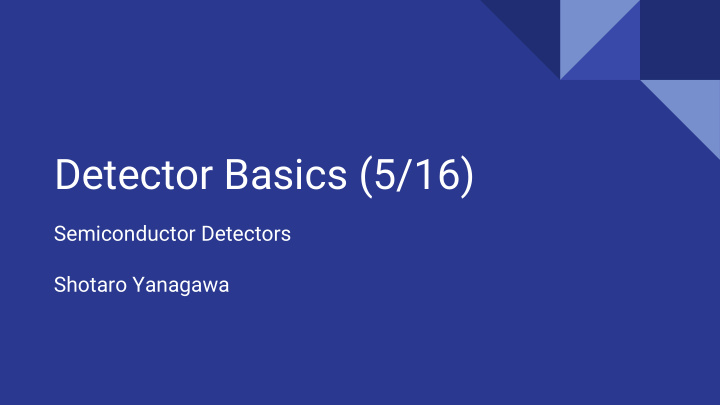



Detector Basics (5/16) Semiconductor Detectors Shotaro Yanagawa
Contents 1. Abstract 2. Principle 3. Detector Reference: Experimental Techniques in Nuclear and Particle Physics Stefaan Tavernier 2
Abstract ・ Mainly used for position sensing devices and photodetectors. ・ Silicon and Germanium are the most commonly used. (CdTe , CdZnTe etc are also being studied) 3 ・ Signals are very small and fast. ・ Extremely good low-noise electronics is essential. 3
Principle (Band) ・ The energy levels of individual atoms form so-called “Bands”. IMPORTANT!! Bandgap → The energy levels closely spaced, and it looks like band. Bandgap ・ Different energy level inside a band are distinguished by wave number. 4
Principle (Band) Much larger than 1 eV -> Insulator In the order of 1 eV -> Semiconductor Bandgap Extremely small bandgap -> Conductor 5
Principle (e-h pair) e ・ If there are so many electrons in conductionband, they will sink to the bottom of the band. →This movement will give rise to a current. 6
Principle (e-h pair) ・ Absorbed energy forms electron-hole pairs. e ・ Hole is a vacancy of electron in Level up valence band. Hole Energy→ ・ The required energy to form e-h pair is proportional to the bandgap. ・ A hole near the top of the band behave as positive particle. 7
Principle (e-h pair) ・ A hole near the top of the band behave as positive particle. e ・ The number of e-h pair N is Level up Hole Energy→ N = E/E i Larger N is good for energy resolution. 8
Principle (Material) Phosphorus : P ・ Phosphorus have 1 more electron Energy levels in 3p orbital than silicon. ・ Phosphorus creates a localised energy level below conduction band. → Decrease bandgap Called “N-type” materials. 9
Principle (Material) Gallium, Boron, Indium ・ These materials create empty acceptor levels above valence band. Acceptor → Acceptors will give rise to holes. Called “P-type” materials 10
Principle (Detection) ・ Additional electron or holes will be collected by collection electrodes. ・ Collected electrons or holes will be the signal. ・ Collection electrode form can be cm-scale pad or strips,or µm-scale pixels. 11
Detectors(silicon) ・ Silicon Semiconductor Detector(SSD) is mainly used for charged particles. ・ SSD is an almost ideal detector for measuring energy of alpha particles. CCD, DEPFET , Vertex detectors...etc 12
Detectors(Germanium) ・ Germanium Semiconduction Detector is mainly used for gamma ray. (Very good resolution) ・ Operated under liquid nitrogen temperature. →Thermal e-h pairs give rise to unacceptable large noise in http://www.thec.pref.tochigi.lg.jp/inst room temperature. 13 rument/ge-sd.htm
Appendix(Si & P & B) Valence electron : 4 Valence electron : 5 Valence electron : 3 Electron in 3p : 2 Electron in 3p : 3 Electron in 2p : 1 14 http://kagakuimage.com/densihaiti.html
Appendix(Doped Crystal) 15 https://alllearnhobby.com/archives/575.html
Appendix (Links) https://www.tel.co.jp/museum/exhibition/principle/semiconduct or.html 東京エレクトロン 半導体の仕組み 16
Recommend
More recommend